Newsletter
 The staff at the Angel Refuge Pet Cemetery & Crematory Inc. are pleased to provide you with an online newsletter.
This fact-filled newsletter is updated on a regular basis.
The staff at the Angel Refuge Pet Cemetery & Crematory Inc. are pleased to provide you with an online newsletter.
This fact-filled newsletter is updated on a regular basis.
Included in the newsletter are articles pertaining to memorial and burial services, end-of-life care, grief counseling and more.
Current Newsletter Topics
Domestic cats are descendants of the African wildcat, and many of the characteristic behaviors of these ancestors are still exhibited by cats today. An understanding of the origin and purpose of such behaviors can help cat owners appreciate their feline companions more fully and lead to an enhanced human-animal relationship.

Social Behavior
Once thought to be a social animals, it is now recognized that domestic cats can form complex social groupings. Studies have repeatedly shown that they form territories or ranges in which they live and defend these from intruders. In stable situations, cat territories can overlap without overt antagonistic interactions.
Communication
The cat has three primary methods of communication: vocal, visual and olfactory. Vocal communication involves a variety of sounds that convey different messages. Visual communication involves the body posture and facial expressions. For example, the position of the ears, hair and tail can offer important information about the emotional state of the cat. Olfactory communication plays a very important role in communication. The deposition of scents via facial marking, anal secretions and urine marking is an important communication tool for the feline.
Sexual Behavior
Female cats are seasonally polyestrus, with peaks in the Northern Hemisphere occurring from January to March and again from May to June. If they are not bred, estrus will last about 10 days and the female will cycle every three weeks for several months. During estrus, the female will engage in increased activity, vocalizations and marking with urine and other glandular secretions. Crouching with rear end elevated and rolling are common body postures that a female may exhibit during estrus.
Eating Behavior
In the wild, the cat developed as a solitary hunter that targeted various small prey. This led to an eating pattern of multiple small meals with considerable variety in the diet. Many domesticated cats continue this pattern and exhibit a preference for a variety of foods.
Bathroom Behavior
Kittens start to eliminate independently at about 4 weeks of age. They instinctively prefer to eliminate in fine particulate material with good drainage. Most cats will investigate a potential spot, dig a hole and pass urine or feces in the squatting position. Cats usually will then cover the elimination.
Sleeping Patterns
Although cats have traditionally been described as nocturnal creatures, they are actually crepuscular by nature, which means that they are more active in the twilight and evening hours. The average adult cat spends 10 hours per day sleeping and an additional five hours resting.
The loss of a cherished animal companion can cause extreme sadness, intense guilt and a whirlwind of other emotions. Often, you will seek answers to questions that may not be black and white. Below, you will find some of the most common questions pet owners ask of themselves while grieving the death of a pet.
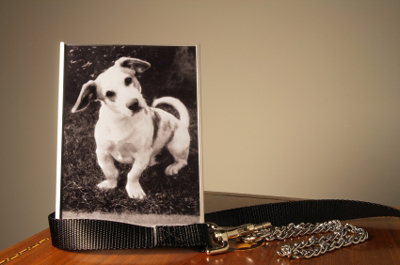
1. When is the right time to euthanize a pet?
Your veterinarian will make a recommendation based on your pet's physical condition and long-term outlook. You, however, have the unique insight into your pet's daily quality of life. By evaluating your pet's health honestly, you will be able to work with your veterinarian to come to the most humane decision for your individual pet. The decision to euthanize will never be easy, but is often the final act of love you can provide a pet who is suffering.
2. Should I stay with my pet during euthanasia?
This is a completely personal decision that you will need to make. Many pet owners want to be there for their pets and witness it so they can see it happened peacefully and without pain. This can be traumatic, but not witnessing the death may make it harder to accept that the pet is really gone. Also, you want to gauge your own emotional strength- if you have an uncontrolled outpouring of emotions before your pet passes, it may be upsetting for him or her to witness. Euthanasia can sometimes be performed at home. Discuss your options with your veterinarian beforehand.
3. I've heard of the stages of grief, but what are they?
The grieving process is often illustrated by five stages: denial, anger, bargaining, depression and acceptance. Typically, you will move through them progressively, but everyone grieves in different ways. You'll know you're beginning to heal when you're thinking more rationally and more often of the good times you shared with your pet rather than of the "what-ifs" and the guilt.
4. How can I cope with my feelings?
Having someone to share your feelings with will help you not have to keep them locked up inside. Don't deny how you feel or simply put on a brave face. You must acknowledge your feelings to work through them. Some of your thoughts may be misguided and as time passes you will be able to realize this. Do whatever works best for you as a means of emotional expression – go somewhere secluded and scream, cry, talk, write, paint, create a memorial, or find a new activity to fill the time you previously would've spent with your pet.
5. Should I just get over it?
It is common to hear the phrase "it was just a pet" when others find your emotions to be too extreme or too long-lasting. These people aren't aware that the death of a pet creates the same emotional response as the loss of a human friend or family member. Grieving is natural and thousands of pet owners can attest to that.
6. Who can I talk to?
Share your feelings with family or friends who have pets. Reminisce about your pet. Or, speak with your veterinarian or local humane association to identify pet loss counselors or support groups. Hospitals and churches also often have resources for grief support.
7. Should I do burial, cremation, or disposal?
This is another decision which should be based on your personal wishes. It can be easiest to have a clinic dispose of your pet's remains (often for a fee), but many prefer something more formal. Based on your living situation, a burial at home may be a good choice. However, both burial and cremation depend on your personal or religious values, finances and future plans. Your veterinarian or an online search will provide options available in your area.
8. What should I tell my children?
Be honest with your children and provide as much information as they seek in a way that matches their age and maturity level. Saying their pet was "put to sleep" is not advised, as they may begin to fear bedtime. Allow your children to grieve in their own ways and be open about your own emotions around them rather than teaching them to keep it all inside.
9. Will my other pets get depressed?
Your other pets may notice a change in the household. Based on their relationship, some may search for their companion, eat less and seem to be grieving. Giving your surviving pets extra love and attention during this time will be beneficial not only to them, but to you as well.
10. Should I get a new pet right away?
Generally, it is best to allow yourself time to work through your grief and loss before introducing a new pet into your home and life. A new pet is a unique individual, not a replacement. Try to avoid getting one that looks the same or naming it the same as your deceased pet, and don't expect it to behave exactly the same either. Getting a new pet too soon may lead to resentment or feelings of disloyalty because you still want your old pet back.
How you wish to handle your pet's remains after death is a personal choice dependent on many factors. Although cremation has become a popular option, other pet parents still prefer burial – either at home or in a nearby pet cemetery. Burial provides the bereaved with a sacred spot where they can go to visit with their deceased companion. It also allows the owner to feel that his or her pet is still present, still at home and not soon to be forgotten.
A burial site can be adorned with flowers, a personalized headstone or grave marker, or even a statue. Many pet parents will plant a flower or tree atop their pet's grave, or bury their pet beneath an existing and protective tree or shrub.
The Options
Home Burial
Home burial is not always an option. For pet owners who rent, move frequently, or live in an urban area, it may not make sense or it may be forbidden or illegal. Many cities prohibit home burials because of the potential hazard it may cause to public health.
If you do opt for home burial, ensure that your grave site is in an area that won’t be disturbed, is at least three feet deep, and that your pet's body is wrapped in or placed in something which is biodegradable.
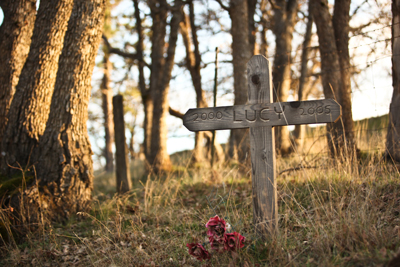
Pet Cemetery Burial
Some pet owners prefer the formality of a cemetery burial – with or without an accompanying service. Others simply do not have the space of their own to bury a pet at home. Having your pet's remains buried in a pet cemetery comes with the assurance that the grave site will always be cared for and will never be disturbed. This can be reassuring for older pet parents or those who may move in the future and not be able to relocate their pet's remains.
Burial in a cemetery comes with many options for headstones and other decorative add-ons for your pet's grave or casket. Additionally, many companies exist that can pick up your pet's remains and help make arrangements for a complete funeral and memorial service if that is what you desire. Most states have several pet cemeteries. To locate the one nearest you, consult with your veterinarian or visit the International Association Of Pet Cemeteries & Crematories or the Pet Loss Professionals Alliance websites.
Ultrasound is a non-invasive, modern technique that produces a visual imprint of the interior of the body. It allows the doctor to achieve a depth of detail that is not possible with X-rays.
Echocardiography is a standard, non-invasive technique for assessing cardiac anatomy, pathology and function. High-frequency sound waves produced from a hand-held device are directed at the heart. The sound waves are reflected back to the machine and an image is produced. This image is transmitted to a video monitor where it can be seen. The image may be still or moving.
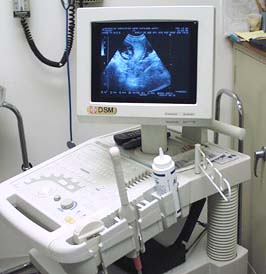
Veterinary Ultrasound Machine
Ultrasound uses sound waves, is non-invasive, painless, uses no dies and has no obvious harmful effects. It is perfect for diagnosing many types of heart problems.
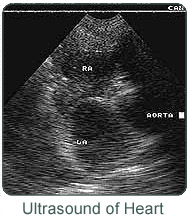
The heart is a very complex organ. It has four valves, an electrical conduction system, and four chambers, all of which are crucial to its function. As in people, animals suffer from a wide variety of heart diseases. In order to correctly diagnose and treat these diseases, it is necessary to see inside the heart, visualize the movement of the chambers, and to look at the valves in motion. This is the area where ultrasound predominates. Using ultrasound, it is possible to watch the heart in motion and to measure each of its’ parts. Ultrasound also allows the doctor or technician to measure the actual physical effects of various heart medications and to carefully adjust dosages.
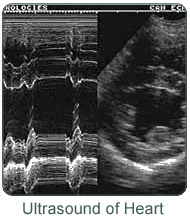
Most heart diseases are treatable, and in most cases, animals can live normal lives once the nature of their condition is under control.
How you wish to handle your pet's remains after death is a personal choice dependent on many factors. While some pet parents still prefer burial, cremation has become the most popular option. This may be because more people are renting or living in urban areas where home burial is often prohibited. Some believe that a body is merely a receptacle for a spirit and that more attention should be placed on honoring the memory of a pet than on its remains.
Whatever your beliefs may be, cremation offers the bereaved the option of having a pet's remains returned. They can be kept in a keepsake urn or spread somewhere sentimental. Some veterinarians perform crematory services or there are many crematories who cater just to pets. Since it has become so popular, there are several affordable options.

Private & Viewing
A private cremation ensures that your pet will be cremated alone and that the ashes you receive will be solely his or hers. Viewing cremations are sometimes possible, where you and your family can witness the process from a separate viewing room. This often provides the bereaved with the reassurance they their pet's remains were treated properly and with respect.
Semi-Private
In a semi-private cremation, several deceased pets are placed in the same chamber and divided by a partition. While the majority of the ashes you receive back should be those of your pet, some co-mingling of ashes does occur. Be sure to clarify which option you desire (and are paying for) as semi-private is sometimes labeled as private.
Communal
If having your pet's ashes returned to you is not something you desire, a communal cremation may be the best option. It results in the co-mingling of several deceased pets' ashes who are cremated together without any partitions separating the bodies.
Maintaining your dog in top physical shape and optimum health is the goal of every responsible dog owner. It is also your veterinarian's goal, and together, you can ensure that your pet stays healthy for years to come. Crucial to maintaining your dog's good health is the routine physical examination that your veterinarian performs on your pet.
Check-ups are important because they provide an opportunity to prevent diseases or even avoid them altogether. Unfortunately, many pet owners tend to underestimate the value of these visits because their pets appear to be healthy. However, this may be deceiving, since many diseases are often not evident in the early stages.
What Happens During A Wellness Examination?
Before the physical examination begins, your veterinarian asks you questions concerning your dog's state of health. This is very important for determining whether or not there are problem areas that need to be addressed. After obtaining a history, your veterinarian performs a physical examination on your dog. Starting at the head, your veterinarian examines the eyes, ears, face, and mouth. Examining the teeth is especially important since up to 85% of all dogs and cats over four years of age have some degree of periodontal disease! Early detection of periodontal disease is important, not only for effective treatment but also future prevention.
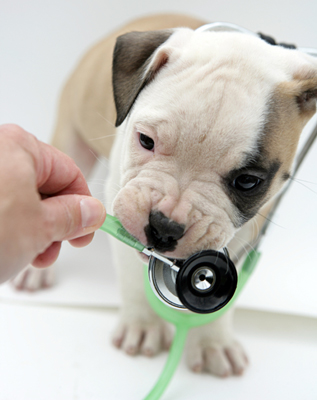
Health & Behavioral Risks to Consider
• Heartworm- Heartworm disease is a serious threat that causes cardiovascular weakness and lung incapacity. Caused by Dirofilaria immitis, these worms plug up blood vessels, which places an increased workload on the heart, along with restricted blood flow to the lungs, kidneys, and liver. This can eventually lead to multiple organ failure, including heart failure and death. Visible signs of the disease often do not appear before the infection has caused significant and irreversible internal damage. As part of an annual physical examination, your veterinarian can perform a simple test to detect heartworm disease and prescribe an easy-to-use preventive.
• Obesity- Your veterinarian can also determine whether or not your dog has an obesity problem. Obesity affects almost one out of every three pets, making it the most common nutritional disease among dogs and cats. Through visual assessment and palpation, your veterinarian can advise on whether or not your dog could benefit from a weight-reduction program.
• Diet- Diet is one of the most important considerations in health maintenance. Its importance lies not only in optimizing a pet's health, but also in the prevention and management of many diseases. Nutritional counseling is an essential part of the veterinarian's checkup and many owners use the opportunity to gain valuable advice on what to feed their pets.
• Obedience- Training is important for your pet's health because behavioral problems account for more deaths in dogs than any known disease. In fact, a well-trained and obedient dog is more likely to live to a ripe old age than a poorly trained one. Obedience-trained dogs are less likely to be involved in car accidents and dogfights, tend to be happier, and are less likely to have behavioral problems. The checkup provides an opportunity to discuss training techniques and behavior concerns with your veterinarian.
Veterinarians take many things into consideration before recommending humane euthanasia for a sick, injured or elderly pet. When it comes to setting your own mind at ease, there are ways to rate or measure your pet's overall well-being.
The Veterinary Medical Center at Ohio State University published a survey designed to illustrate your pet's quality of life which was adapted from several other common methods. The survey asks you, the pet owner, to rate 25 different prompts on a scale from one to five. A score of one indicates strong agreement or a condition that is present all the time or is severe; a score of five indicates strong disagreement or a condition that is never present and nonexistent. Thus, higher scores indicate a better quality of life.
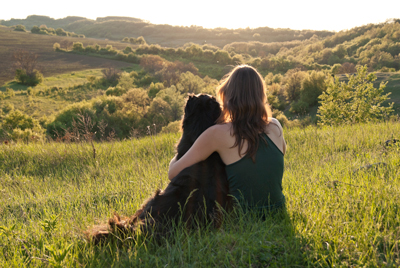
The Survey
Scale
1: Strongly Agree / All the Time / Severe
2: Agree / Most of the Time / Significant
3: Neutral / Sometimes / Mild
4: Disagree / Occasionally / Slight
5: Strongly Disagree / Never / None
My pet...
1. Does not want to play
2. Does not respond to my presence or doesn't interact with me in the same way as before
3. Does not enjoy the same activities as before
4. Is hiding
5. Demeanor/behavior is not the same as it was prior to diagnosis/illness
6. Does not seem to enjoy life
7. Has more bad days than good days
8. Is sleeping more than usual
9. Seems dull and depressed
10. Seems to be or is experiencing pain
11. Is panting (even while resting)
12. Is trembling or shaking
13. Is vomiting and/or seems nauseous
14. Is not eating well (may only be eating treats or if fed by hand)
15. Is not drinking well
16. Is losing weight
17. Is having diarrhea often
18. Is not urinating well
19. Is not moving normally
20. Is not as active as normal
21. Does not move around as needed
22. Needs my help to move around normally
23. Is unable to keep self clean after soiling
24. Has coat that is greasy, matted or rough-looking
25. How is my pet's overall health compared to the initial diagnosis/illness?
Once you have rated each prompt, tally up the number of responses for each number and then place an 'X' on a "Quality of Life line" labeled "Good" at one end and "Poor" at the other according to your most frequent response.
The purpose of this exercise is to help you better visualize your pet's general well-being. Of course, not all pets are the same and what is rated poorly for one may not be so bad for another. For pets currently undergoing treatment, some poor ratings may be liked to symptoms and side effects which will subside. It is always important to discuss your concerns and your pet's overall demeanor with your veterinarian, especially when considering humane euthanasia.
Although it isn’t known for sure if pets grieve the loss of an animal or human companion in the same way humans do, many do express their awareness that something has changed. Depending on how long your pets spent together and what their relationship was like, a death can create a significant void within the home that your surviving cat or dog may notice.
Symptoms of Grief
The ASPCA studied pet behavior after the loss of a pet companion during the nineties and found that 66 percent of dogs exhibited four or more behavioral changes. Some of these changes included:
• Loss of appetite
• More needy for attention
• More or less vocal than normal
• Restless during sleep
• Searching for deceased pet
• Wandering aimlessly
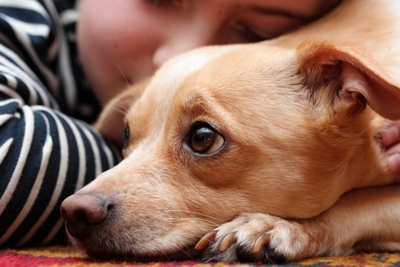
Allowing Your Pet to Say Goodbye
Many pet owners will attest to the searching behavior their surviving pets seem to exhibit after the death of a companion. When a friend suddenly leaves the house and doesn't return, he or she may anxiously wait for their return or search the house and yard hoping to find them. It has been suggested that allowing your pet to see the deceased pet's body can help him or her understand what has happened.
During this visit, your pet may: sniff, paw at, or try to "bury" the body; lay beside it; howl or whimper; invite play by bringing over a toy; or do nothing at all.
If letting your pet say goodbye in this way is not possible, consider clipping a lock of your deceased pet's hair for your surviving pet to smell. If your pet is showing any signs of grief, provide plenty of extra love and attention.
So you have a cute furry companion who loves to play fetch and go to the dog park. But are they well-behaved? It really doesn't matter whether your canine is a four-pound Chihuahua or a 104-pound Rottweiler. An untrained dog is an invitation to disaster. And a dog that won't come when called is always in danger.
As a pet owner, you should be committed to training your dog. So if your adorable companion has the tendency to bark to get your attention or to run away when you call for them, it's time to do something about ending that poor behavior.
Now for the good news: dogs are easily trained. That's probably the reason why dogs have long been America's favorite pet. Despite the fact that they train relatively easily, however, you still have to do the job. One way to make training simple is to get a breed that readily adapts to your lifestyle and that corresponds to what you want in a canine companion. Serious breeders can help you with this decision. They should tell you about their breed's inherent trainability—advice you should heed before making your final decision.

Rest assured that training does not strip a dog of natural instincts or "joie de vivre." After all, these are the things that attract people to dogs in the first place. We want you to celebrate the canine spirit, not abuse it.
What training does, however, is structure the dog's responses, giving you a good companion. Training gives you an animal you can trust, rely on, even flaunt. In fact, it establishes a channel of communication between you and your dog that significantly enhances your mutual respect and friendship.
Every civilized dog should know at least five basic commands: heel, sit, down, stay and come. These commands form the core of the exercises required for a Companion Dog degree in an American Kennel Club Novice Obedience competition. Even if you don't take your dog beyond these beginning lessons, they are absolutely essential in making every dog a true companion.
Incidentally, you train your dog to understand its name in much the same way you train it to do anything—by simple, repetitive action. As far as the name goes, make sure everyone in the household is using the same name. And, you can teach an older dog a new name, if you must.

